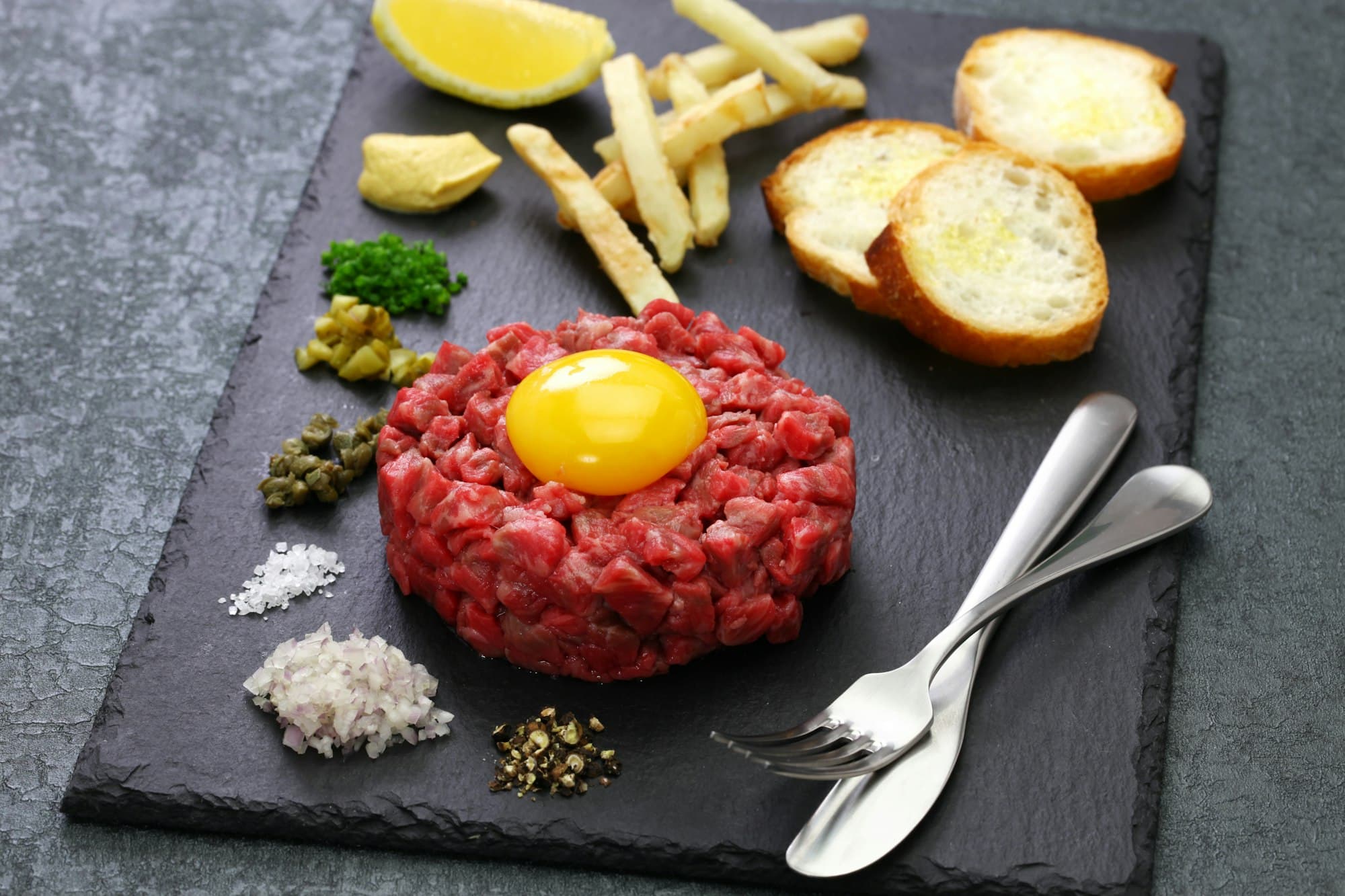What’s the Key to a Classic French Beef Tartare with Capers and Quail Egg?

A classic French dish that has stood the test of time, beef tartare is a delicacy for many food enthusiasts. Rich in flavour and texture, this raw meat dish is a testament to the French’s penchant for simplicity and quality in their dishes. Prepared with fresh, raw beef steak, usually finely chopped or minced, various seasonings, and typically crowned with an egg yolk, it’s a dish that’s as visually stunning as it is delectable.
But what’s the secret to creating a perfect classic French beef tartare? The key lies in the choice of ingredients, the precision in preparation, and the delicate balance of flavours. Let’s delve further into the world of this raw meat marvel, tartare, and discover its secrets.
A lire également : What’s the Secret to a Deliciously Moist and Nutty Carrot Cake with Cream Cheese Frosting?
Choosing the Right Beef for Tartare
The selection of beef is crucial in creating an exquisite tartare. As the primary ingredient, the quality, freshness, and cut of the beef will greatly influence the eventual taste and texture of the dish.
When it comes to beef for tartare, the best option is generally a high-quality cut of fresh steak. A tender and lean cut such as filet mignon is often the go-to choice for many chefs. However, there’s another beef variety that has been gaining popularity for its distinct flavour and texture – the Wagyu beef.
Dans le meme genre : How to Craft a Gourmet Grilled Portobello Mushroom Burger with Blue Cheese?
Wagyu, which literally means "Japanese cow", is renowned for its intense marbling and tender texture. The high amount of intramuscular fat in Wagyu gives it a rich, buttery flavour that brings a unique twist to the traditional tartare.
Another important point to remember is that the beef should be used as fresh as possible. Since tartare is a raw dish, using the freshest meat not only ensures the best taste but is also crucial for food safety.
Preparing the Beef: To Chop or To Cut?
Once you have your perfect beef, the next step is the preparation. Traditional French tartare calls for the beef to be finely chopped, not ground.
The reason for this is twofold. First, chopping the beef allows for a better texture and mouthfeel. Unlike ground beef, chopped beef provides a nice bite and allows the meat to blend well with the other ingredients without becoming too mushy. Second, chopping the meat helps to retain its freshness, as ground beef tends to oxidize faster.
While it might be tempting to use a food processor for ease and speed, we recommend using a sharp knife to manually chop the beef. This might require some extra time and effort, but trust us, the result is worth it!
The Role of Capers in a Classic French Tartare
Capers, these small, green flower buds are an essential ingredient in a classic French tartare. They add a tangy punch and a hint of sharpness to the rich, raw beef.
Not only do capers add a unique flavour, but they also contribute to the overall texture of the dish. Their slightly crunchy texture contrasts beautifully with the smoothness of the raw meat and the creamy egg yolk.
For the best results, use capers that have been preserved in salt rather than vinegar. Salt-cured capers have a more concentrated flavor and are less acidic than their vinegar-pickled counterparts.
Assembling the Tartare: The Sauce and The Egg
Once your beef is chopped and your capers are ready, it’s time to bring everything together. This is where the sauce comes in.
Tartare sauce typically includes ingredients such as olive oil, Dijon mustard, and Worcestershire sauce. The olive oil adds a smoothness and richness to the tartare, while the Dijon mustard provides a slight tanginess that cuts through the richness of the beef. The Worcestershire sauce, on the other hand, lends a bit of sweetness and depth of flavour.
And of course, we can’t forget the pièce de résistance of a classic French tartare – the egg yolk. Traditionally a raw yolk is used, but in this case, we’re going to use a quail egg. The yolk is placed in the center of the tartare, adding a velvety, rich touch to the dish.
As you break the yolk and stir it into the tartare, it creates a naturally creamy sauce that beautifully coats the chopped meat and capers.
The Final Touch: Presentation and Serving
Like many French dishes, presentation is key. Tartare should be served immediately after preparation to ensure freshness and optimum taste.
The traditional way of serving tartare is molding the mixture into a round shape, placing the yolk in the center, and garnishing with a sprinkle of fresh chives or parsley. Whatever the method, remember that tartare is as much a feast for the eyes as it is for the palate.
In the end, the key to a classic French beef tartare lies in the careful selection and preparation of high-quality ingredients, the refined yet straightforward techniques, and an appreciation for the raw beauty of this remarkable dish.
Incorporating Truffle Oil in the Tartare Recipe
In the quest for creating the perfect classic French beef tartare, every detail matters. Among the various ingredients that can be used to elevate this dish, one stands out – truffle oil. This luxurious, aromatic oil can turn a simple tartare into a gastronomic symphony.
Truffle oil is made by infusing a high-quality olive oil with either white or black truffles. The earthy, pungent aroma of the truffles permeates the oil, giving it an intense, unique flavour. Just a small drizzle of truffle oil can go a long way in enhancing the taste of your tartare.
Truffle oil complements the raw beef beautifully, adding a depth of flavour that intensifies the overall experience of eating the tartare. It adds a luscious, earthy note that balances the richness of the meat and the creaminess of the egg yolk.
However, it’s important to use this ingredient with caution. Truffle oil is potent, and too much of it can overpower the other flavours in the tartare. Instead, drizzle just a few drops over the dish before serving, allowing the oil to enhance rather than dominate the flavour profile.
Therefore, in your quest to make a perfect tartare, don’t overlook the power of truffle oil. Its extraordinary flavour and aroma can add a gourmet touch to this classic French dish.
Low Carb and High Quality: The Nutritional Benefits of Beef Tartare
Beef tartare doesn’t only appeal to the foodies among us, it also strikes a chord with those of us who watch our diet. It’s a high-protein, low-carb dish, making it an excellent choice for those following a ketogenic or low-carb diet.
The raw beef used in tartare is a great source of protein, essential for muscle growth and repair. It’s also low in carbs, which can help to maintain a healthy weight and support blood sugar control.
The high-quality steak used in a tartare recipe, particularly if you opt for Wagyu, also provides a significant amount of omega-3 fatty acids. These are known for their heart-healthy benefits, including reducing inflammation and lowering the risk of heart disease.
Additionally, the egg yolk adds a good dose of vitamins and minerals to the dish. Raw egg yolk is rich in Vitamin B12, Vitamin D, folate, and choline, all essential nutrients for overall health.
However, while beef tartare can be a nutritionally balanced dish, it’s crucial to remember the importance of food safety. Always ensure you use the freshest ingredients possible and follow proper hygiene practices when preparing and serving the dish.
Conclusion: The Art of a Classic French Tartare
Creating a classic French beef tartare is a culinary journey that takes one through the subtleties of high-quality ingredients, meticulous preparation, and a perfect balance of flavours. It’s a journey that starts with the choice of the perfect cut of beef, continues with the precision in chopping and pairing it with punchy capers and luxurious truffle oil, and ends with a crowning glory of a silky raw quail egg yolk.
Beef tartare is more than just a dish; it’s a celebration of simplicity and quality. It’s a tribute to the French culinary tradition that values the raw and natural beauty of its ingredients.
Whether enjoyed as a starter at a dinner party or as a main dish at a high-end restaurant, a well-made tartare never fails to impress. Remember, the secret to a perfect tartare is in its simplicity: using the freshest ingredients, minimally processed and elegantly presented. It is a testament to the age-old saying, less is indeed more.
So, take out your chef’s knife, source your ingredients, and embark on the journey to create your very own classic French beef tartare. Bon appétit!
